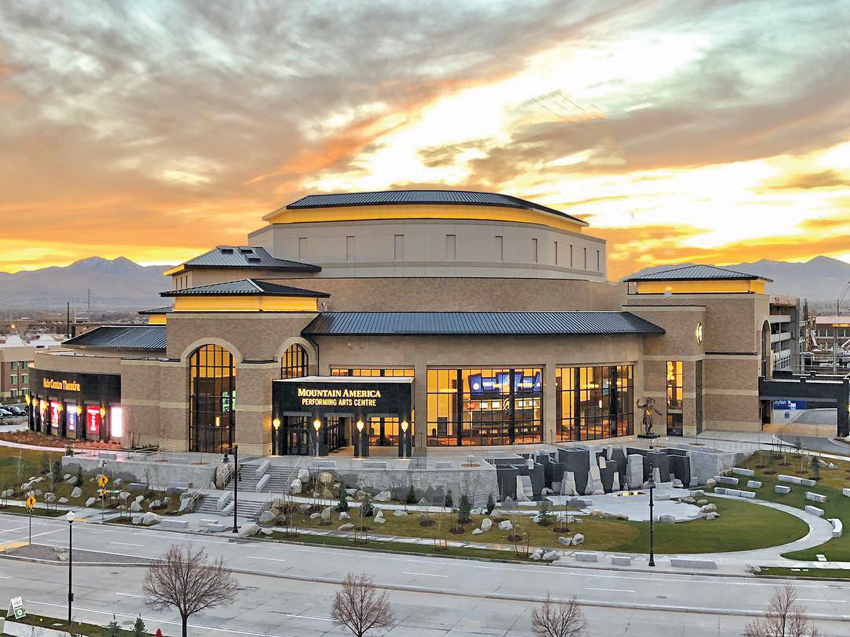There are many reasons that a project may need to be designed to mitigate exterior noise,” explains Harold Merck, INCE, LEED AP, principal at Merck & Hill Consultants. “Some spaces are sound sensitive, like the audience chamber or stage in a performing arts facility, while others have been constructed on noisy sites, near a railroad track or under a flight path. Sometimes the mechanical equipment on the roof generates a lot of noise that needs to be addressed as well. Whatever the reason, the building envelope can be designed to control the transmission of sound, just as it is designed to control temperatures and prevent water infiltration, and the roof area plays a critical role in achieving a sound management objective.”
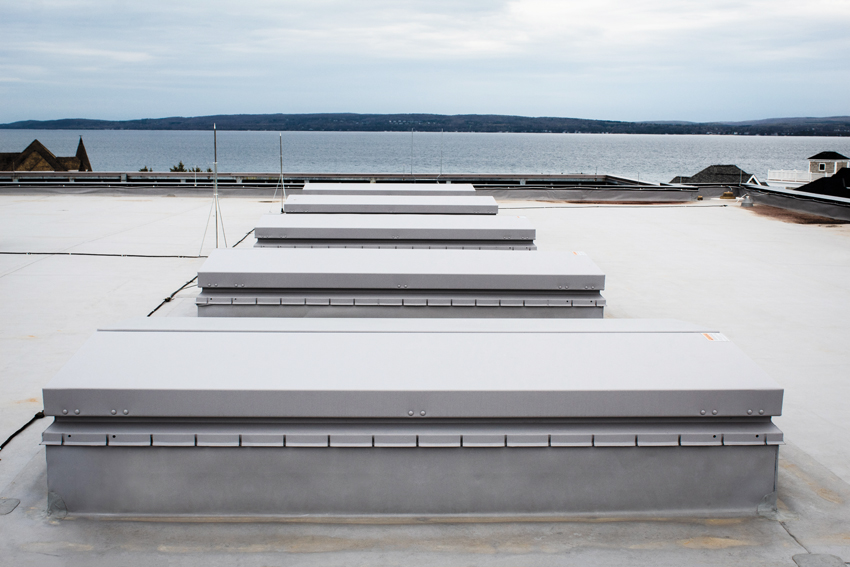
All photos courtesy of The BILCO Company
Buildings that contain large, undivided open interiors, such as performing arts facilities, theaters, casinos, and convention centers, can benefit from acoustic smoke vents that prevent environmental noise from trespassing through the roof into the sound-sensitive interior spaces.
When projects must deliver greater levels of exterior sound mitigation, architects are required to spend more time shoring up the paths through which sound can most easily move from the outside to the inside. Openings are a common target of their attention. Just as openings in a building facade—doors and windows—can require soundproofing to reduce the transmission of noise from one side of the wall assembly to the other, openings made on the roof to accommodate automatic smoke vents or other products can benefit from solutions that have been specially engineered to manage sound.
This course explores the application of sound-rated smoke vents to isolate exterior noise and protect the acoustic performance and comfort of the interior space. Various metrics used to measure sound-buffering performance will be compared. An overview of the building codes that require the use of these automatic smoke vents will also be discussed, and the benefits of these life-safety products will be summarized. Projects where these acoustical smoke vents have been installed are also profiled.
Great Lakes Center for the Performing Arts
The Great Lakes Center for the Arts is a 40,000-square-foot, state-of-the-art performance facility located in Petoskey, Michigan, a popular vacation destination for families that is now also an enticing space for world-class performers. At the heart of this $25-million project is a 525-seat auditorium outfitted with cutting-edge sound technology found in only a few theaters across the country. Both the beauty of the building and the functionality of the acoustics were critical aspects of the design that architects considered while creating this venue to deliver a top-tier experience.
“This building adds a space for world-class performers to stop that did not exist in Northern Michigan,” says Jason Novotny, lead architect for TowerPinkster, the firm that designed the building. “With this being a high-performing acoustical environment, we designed a separate structure for the performance hall from the remainder of the building. This was solely for acoustical isolation of building elements.”
“With the potential for more than 500 visitors, our team knew we would have a need for a dependable smoke ventilation system,” Novotny explains. “The acoustical smoke vents with their acoustical sound-reducing characteristics became a part of this ‘shell-within-a-shell’ structure.”
Smoke vents installed in the roof of the facility provide significant fire and life-safety benefits. In the event of a fire, the vents open automatically to allow smoke, heat, and gases out of the burning building. This prevents the buildup of these dangerous elements and enables air quality and visibility to be maintained so that guests can safely exit the building and firefighters can enter to do their job.
Some smoke vents are designed to block outside noise from trespassing into the interior and compromising the sound comfort level of the indoor space. They are called acoustically sound-rated automatic smoke vents. There are five of these acoustical smoke vents in the roof of the Great Lakes Center for the Arts that block outside noise from penetrating into the interior and help to maintain the quality of the sophisticated sound system.
Beyond the attention to creating impressive sound quality, the architectural team went to great lengths to develop a theme for the space that incorporated local colors and textures. “We included aged copper, Petoskey stone, natural sedimentary rock, and of course, the beautiful blue waters of Lake Michigan,” Novotny says.
“The color palette and design features intentionally reflect the beauty of Northern Michigan, with blues, sands, grays, copper, and patterns and textures that evoke the water of Lake Michigan,” says Jill O’Neill, executive director of the center. Even the roof is an architectural element with the curvilinear wood ceiling resembling waves of the nearby lake. There is also a large rooftop terrace with stunning lake views.
Regardless of whether an audience is enjoying classical music, ballet, intellectual dialogue, comedy, country music, cinema, jazz, or any other event hosted at the Great Lakes Center for the Arts, it will be an experience to remember. To better understand how the design team created this safe, code-compliant, and sophisticated facility, let us now take a closer look at the acoustical smoke vents that were selected for the roof.

Architects of the Great Lakes Center for the Arts in Petoskey, Michigan, selected sound-rated smoke vents to provide life-safety benefits and support the world-class performance space.
There are many reasons that a project may need to be designed to mitigate exterior noise,” explains Harold Merck, INCE, LEED AP, principal at Merck & Hill Consultants. “Some spaces are sound sensitive, like the audience chamber or stage in a performing arts facility, while others have been constructed on noisy sites, near a railroad track or under a flight path. Sometimes the mechanical equipment on the roof generates a lot of noise that needs to be addressed as well. Whatever the reason, the building envelope can be designed to control the transmission of sound, just as it is designed to control temperatures and prevent water infiltration, and the roof area plays a critical role in achieving a sound management objective.”

All photos courtesy of The BILCO Company
Buildings that contain large, undivided open interiors, such as performing arts facilities, theaters, casinos, and convention centers, can benefit from acoustic smoke vents that prevent environmental noise from trespassing through the roof into the sound-sensitive interior spaces.
When projects must deliver greater levels of exterior sound mitigation, architects are required to spend more time shoring up the paths through which sound can most easily move from the outside to the inside. Openings are a common target of their attention. Just as openings in a building facade—doors and windows—can require soundproofing to reduce the transmission of noise from one side of the wall assembly to the other, openings made on the roof to accommodate automatic smoke vents or other products can benefit from solutions that have been specially engineered to manage sound.
This course explores the application of sound-rated smoke vents to isolate exterior noise and protect the acoustic performance and comfort of the interior space. Various metrics used to measure sound-buffering performance will be compared. An overview of the building codes that require the use of these automatic smoke vents will also be discussed, and the benefits of these life-safety products will be summarized. Projects where these acoustical smoke vents have been installed are also profiled.
Great Lakes Center for the Performing Arts
The Great Lakes Center for the Arts is a 40,000-square-foot, state-of-the-art performance facility located in Petoskey, Michigan, a popular vacation destination for families that is now also an enticing space for world-class performers. At the heart of this $25-million project is a 525-seat auditorium outfitted with cutting-edge sound technology found in only a few theaters across the country. Both the beauty of the building and the functionality of the acoustics were critical aspects of the design that architects considered while creating this venue to deliver a top-tier experience.
“This building adds a space for world-class performers to stop that did not exist in Northern Michigan,” says Jason Novotny, lead architect for TowerPinkster, the firm that designed the building. “With this being a high-performing acoustical environment, we designed a separate structure for the performance hall from the remainder of the building. This was solely for acoustical isolation of building elements.”
“With the potential for more than 500 visitors, our team knew we would have a need for a dependable smoke ventilation system,” Novotny explains. “The acoustical smoke vents with their acoustical sound-reducing characteristics became a part of this ‘shell-within-a-shell’ structure.”
Smoke vents installed in the roof of the facility provide significant fire and life-safety benefits. In the event of a fire, the vents open automatically to allow smoke, heat, and gases out of the burning building. This prevents the buildup of these dangerous elements and enables air quality and visibility to be maintained so that guests can safely exit the building and firefighters can enter to do their job.
Some smoke vents are designed to block outside noise from trespassing into the interior and compromising the sound comfort level of the indoor space. They are called acoustically sound-rated automatic smoke vents. There are five of these acoustical smoke vents in the roof of the Great Lakes Center for the Arts that block outside noise from penetrating into the interior and help to maintain the quality of the sophisticated sound system.
Beyond the attention to creating impressive sound quality, the architectural team went to great lengths to develop a theme for the space that incorporated local colors and textures. “We included aged copper, Petoskey stone, natural sedimentary rock, and of course, the beautiful blue waters of Lake Michigan,” Novotny says.
“The color palette and design features intentionally reflect the beauty of Northern Michigan, with blues, sands, grays, copper, and patterns and textures that evoke the water of Lake Michigan,” says Jill O’Neill, executive director of the center. Even the roof is an architectural element with the curvilinear wood ceiling resembling waves of the nearby lake. There is also a large rooftop terrace with stunning lake views.
Regardless of whether an audience is enjoying classical music, ballet, intellectual dialogue, comedy, country music, cinema, jazz, or any other event hosted at the Great Lakes Center for the Arts, it will be an experience to remember. To better understand how the design team created this safe, code-compliant, and sophisticated facility, let us now take a closer look at the acoustical smoke vents that were selected for the roof.

Architects of the Great Lakes Center for the Arts in Petoskey, Michigan, selected sound-rated smoke vents to provide life-safety benefits and support the world-class performance space.
Introducing Automatic Smoke Vents
Automatic smoke vents are openings in the roof that are fully insulated and weathertight. When a fire is detected, the smoke vent covers open automatically, allowing the heat, smoke, and gasses produced by the fire to escape the building instead of remaining trapped inside. Once the fire has been extinguished, the covers on the smoke vent can then be reset, and the roof returns once again to a fully insulated, weathertight, and fire-ready structure.
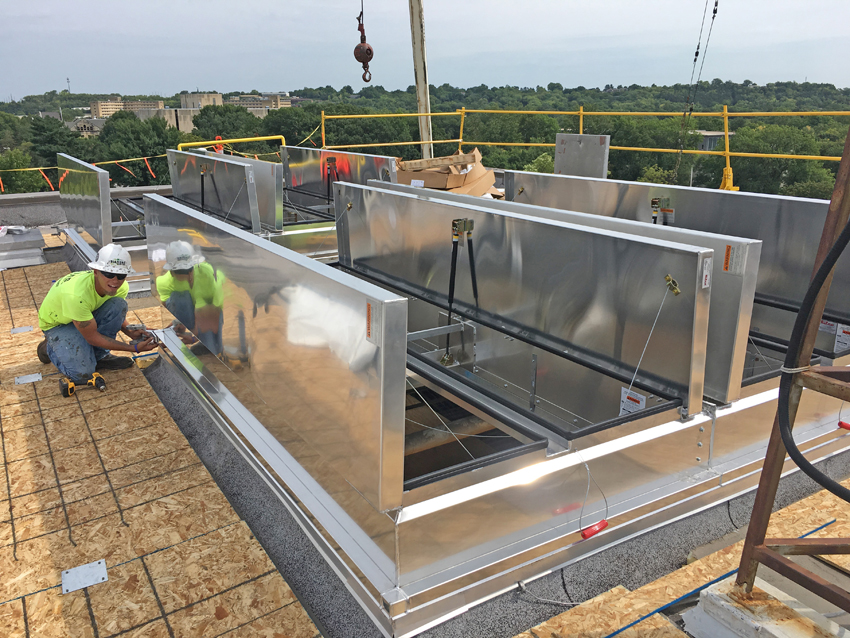
Mechanically opened automatic smoke vents consist of covers, often constructed of aluminum or steel, that provide a fully insulated and weathertight assembly when closed and then open automatically to release smoke and gas in the event of a fire.
Automatic smoke vents are an important and effective fire management tool for buildings with large expanses of unobstructed space, such as convention centers, auditoriums, retail stores, schools, manufacturing facilities, warehouses, casinos, and theaters. In these types of applications, where compartmentalization is a difficult fire-containment strategy to execute, smoke vents enable smoke, heat, and gasses to make a swift exit near the area where the fire originated. This removes these noxious elements from the building more quickly than other solutions and prevents them from spreading throughout the building and causing more damage and destruction. The open smoke vents also perform a life-safety function in allowing more time for people to escape the fire and smoke.
There are two categories of automatic smoke vent solutions found on the market: mechanically opened and gravity opened.
Mechanically opened automatic smoke vents consist of covers that are over-sprung by a mechanical lift assist and held closed by a latching mechanism with a fusible link. The fusible link—the same technology commonly used as the trigger mechanism in fire sprinkler systems and automatic fire doors—melts at a specific temperature, opening the vent doors when temperatures at the ceiling reach a certain level. When released, engineered lift assistance opens the covers and locks them in an open position, allowing the heat, smoke, and toxic fumes gathering at the ceiling to escape the burning building. Once the fire is under control, the vents can easily be reset from the roof level. These automatic smoke vents are the most common solution used for smoke and heat removal in large, single-story, undivided buildings.
Gravity-opened vents, also referred to as melt-out domes, do not open by mechanical means. When the heat from the fire reaches the dome material, it shrinks the material until it falls into the building, providing a hole in the roof through which the heat and gas can escape. There are a few notable disadvantages in selecting this technology over the mechanically opened smoke vents. The melt-out domes cannot be reset or designed to activate in response to a fire alarm or smoke detector. Coordinating operation with a sprinkler system is also difficult due the the melting temperature of the domes. Another item to consider is that the dome material could contribute to the fire as it falls into the building. These melt-out smoke ventilation solutions are not often selected, but they do offer architects a less expensive alternative to mechanically operated smoke vents.
Selecting the Right Mechanically Operated Smoke Vent
Mechanically operated smoke vents are largely preferred over gravity-opened smoke vents due to the number of options available with these products that allows architects to choose automatic smoke vents that best complement the types of spaces they are creating. Size, operation, activation mode, cover material, and acoustic control are a few of the features and functionalities that architects can specify to tailor the smoke vent solution to the specific needs of a project.
Size
Automatic smoke vents are available in single-leaf and double-leaf models and in aluminum or prime-painted steel construction. The single-leaf solutions are ideal for smaller, more confined areas like stairwells or elevator shafts. Double-leaf smoke vents are designed for larger areas, and size and spacing are based on building volume and contents. Generally, smoke ventilation requirements for large areas are dictated by fire codes, and usage is coordinated with local fire-protection authorities.
Activation Mode
Standard automatic smoke vents are automatically activated by a fusible link that melts when the temperature at the ceiling reaches 165 degrees Fahrenheit. Different fusible-link release temperatures are available to allow coordination with sprinkler-head activation temperatures. Products can also be specified with an electric latching mechanism that allows the smoke vents to be activated by a fire alarm or smoke-detection system. This feature can be especially useful in applications where the smoke vents are more centrally located because it ensures that the vents will be open, even if a fire starts in an area of the building that is not near the smoke vents.
On-Demand Operation
Sometimes it is nice or necessary to open the automatic smoke vent when there is no fire. For example, there are times that spaces could benefit from more natural ventilation, such as manufacturing environments or stage areas to exhaust heat from overhead lighting. Automatic smoke vents can be equipped so that they can be opened and closed on demand as well. This on-demand control is typically delivered through hand winch or electric motor operation. Rigging can be installed at the floor level, which allows an operator to use a manual winch to open and close the vents. Motorized smoke vents are opened and closed with the simple push of a button.
Translucent Polycarbonate Covers
While most automatic smoke vents feature covers that are solid aluminum or steel, translucent polycarbonate covers can be selected to allow daylight into the building, while the covers remain closed and weathertight. This change in material effectively transforms the smoke vent into a fire-responsive skylight designed to resist ultraviolet (UV) degradation and offer superior thermal performance. Allowing daylight into the floor plan can reduce energy costs and create a more pleasant working environment for building occupants. These solutions are often specified in manufacturing facilities, large atriums, and even schools.
Acoustical Sound-Rated Covers
One of the latest innovations in automatic smoke vent design is improved acoustical sound-rating performance. These acoustical smoke vents guard against noise intrusion when the cover is in the closed position, preventing outside noise from traveling into the interior, while supporting fire and life-safety codes in the event of a fire. The enhanced acoustic performance is the result of a new smoke vent design that incorporates mineral wool insulation and high-density sound-mat material within the unit’s covers and curb. In addition, the acoustical smoke vents feature a heavy-gauge steel construction, custom weather gasketing, gas-spring lift assistance, and a center-mounted gas traction spring to ensure reliable and controlled smoke vent operation. These sound-rated solutions are ideal for concert halls, theaters, and other interior applications that require limited noise intrusion from the outside.
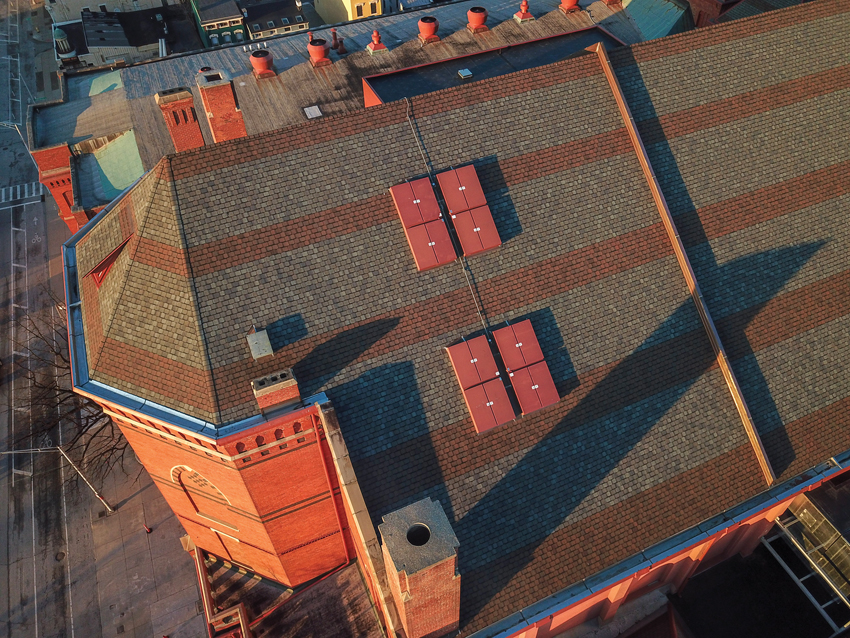
Smoke vents with sound-rated acoustical covers (shown here) feature mineral wool insulation and high-density sound-mat material in the unit’s cover that prevent outside noise from traveling into the interior.
“As a general rule, sound is managed or modified by the mass of the material or assembly through which it passes. The more mass an object has, the greater its ability will be to reduce noise energy. When you look at wall assemblies of the building envelope, they are often comprised of several layers—the finished exterior surface, metal studs, framing, drywall, insulation, an air cavity. These are often sufficient to manage sound, but the doors and windows are relatively lightweight in comparison, and these elements are often the weak spots that are vulnerable to sound penetration. The same concept applies to a roof—the greater the mass of the structure, the better it will manage sound. For example, a concrete roof deck will, in most cases, block sound better than a metal roof deck. Openings in the roof, like the openings that are created for smoke vents, could provide a path that would allow sound to travel into the interior. Architects concerned with sound control will want to make sure that the smoke vent products they select have enough mass in the lid to be comparable to the roof in which they are installed,” Merck says.
Today, sound-rated smoke vents have achieved industry-high sound ratings of STC 50 and OITC 46 to effectively match the sound-rating performance of roof assemblies without penetrations. To fully understand what this means, we will need to briefly explore the basics of sound and the common metrics used to describe the soundproofing effectiveness of a material or assembly.
The Basics of Sound
When looking to control the transmission of sound, both the frequency and decibel level of the sound must be considered. The frequency describes how fast the sound vibrations are moving and is measured in Hertz (Hz). The hearing range of the human ear is generally defined as 20–20,000 Hz. Sounds are typically divided into high-, middle-, and low-frequency categories. Low-frequency sounds are often experienced as a rumble. Bass, thunder, or a tuba are all examples of low-frequency sounds. Middle-frequency sounds often fall in the 500–2000 Hz range and include sirens and human speech. High-frequency sounds start at 2000 Hz. Birds chirping or music from a piccolo are good examples of high-frequency sounds.
The topic of frequency is important when discussing sound management because sounds at different frequencies move through materials differently. While higher frequencies may be effectively absorbed by a certain material, lower frequencies may easily pass through it. In general, very-high- and very-low-frequency sounds are more difficult to attenuate.
The volume of sound is also an important quality to understand when managing environmental noise. Measured in decibels (dB), soft sounds, like a whisper, typically register at 15–20 dB, while a jet engine creates sound at 150 dB. It is important to note that the decibel scale is not linear, but logarithmic. This means that doubling the decibel reading of a sound, say from 15 dB to 30 dB, does not double the noise. Instead, for every 10 dB increase in sound level, the human ear will perceive the loudness as doubled. For example, a sound at the 60 dB level is perceived to be twice as loud as a 50 dB level.
The common environmental sounds that a building facade must be designed to manage can be quite loud. A blog post published by the American National Standards Institute (ANSI) titled "How Loud Is Construction Site Noise?" shared that most construction sounds fell in the range of 80–90 dB. For context, prolonged exposure to sounds over 85 dB or higher can cause damage to the ear. Automobile traffic is one of the main contributors to noise pollution and can generate a lot of noise inside a building. According to CityandStateNY.com, traffic in midtown Manhattan creates between 70 and 85 dB of noise. The sound of a motorcycle can reach 88 dB and trains 100 dB.
Understanding the frequency and decibel level of the environmental noise found at a project site is the first step in creating a building envelope that can effectively manage that noise.
Noise-Control Metrics
“Noise goes both ways,” says Albert Maniscalco, a partner with Cerami and Associates in New York City, a team of acoustical, audiovisual, and design consultants. “Sound can come in and go out. How that facade performs with noise coming in or going out is important to know.”
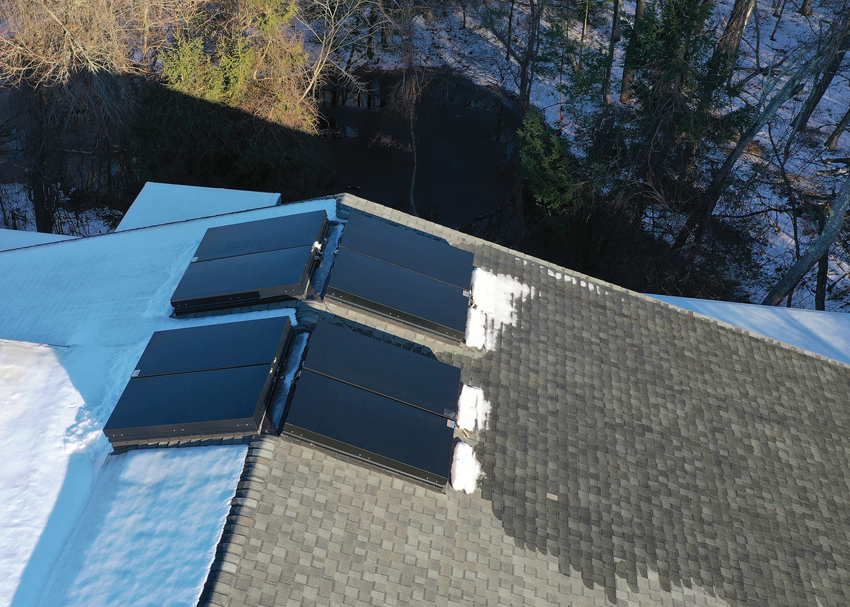
Sound-rated smoke vents have achieved industry-high sound ratings of STC 50 and OITC 46.
There are three metrics used to rate how a construction material or assembly manages sound. They are the STC rating, the OITC rating, and the lesser known ISO-140-18 rating.
STC Rating
Sound transmission class, or STC, measures the soundproofing effectiveness of a material or assembly. More specifically, the metric measures how well a solution prevents sound between the frequencies of 125–4000 Hz from transferring from one area to another. It is most applicable for interior areas filled with middle- to high-frequency noises such as conversation, television, telephones ringing, and office equipment.
Ceilings, floors, doors, windows, interior partitions, and exterior wall assemblies can earn STC ratings. A higher STC rating indicates that the material or assembly is better at stopping sound in the 125–4000 Hz range from trespassing through it. A low STC rating, 20–25, indicates that loud speech generated in one area can be heard in another. A product with a higher STC rating, 50–60, is better at isolating sound, which means that loud speech produced in one area will be barely heard on the other side of the solution, if at all. For comparison purposes, a single pane of glass typically has an STC rating of 27, and a soundproof window over a dual-pane window can achieve an STC rating of 48. A standard wall construction has an STC rating of 50.
One notable weakness of the STC rating is that it does not consider frequencies below 125 Hz. These low-frequency bass sounds include sounds produced by automobiles, trains, and airplanes, which are often responsible for the noise that can transmit through the exterior structure of a building and create unwanted distractions inside a building.
OITC Rating
The outdoor-indoor transmission class (OITC) sound rating rates the transmission of sound between outdoor and indoor spaces. Developed in 1990, this metric is often used to measure the transmission of sounds that fall within the range of 80–4000 Hz. This low-end scale allows the OITC metric to be used to evaluate how well a building facade blocks the problematic, lower-frequency sounds from automotive traffic, construction, and low-flying airplanes. Like STC, OITC is determined by the sound intensity (measured in decibels) that is lost when a sound travels through a barrier. The higher the OITC rating, the better the noise-buffering performance of the material or assembly.

When designing a building envelope to manage low-frequency noise sources—aircraft, traffic, or large rooftop equipment—look for products with a high OITC rating.
ISO-140-18:2006 Rating
Rainfall is another source of noise that the building envelope must be equipped to manage in certain sound-sensitive applications. Imaging the severity of the sound generated by heavy rains falling on a metal roof. Even moderate rainfall can produce sound that measures in at 50 dB.
"ISO 140-18:2006 Acoustics – Measurement of sound insulation in buildings and of building elements – Part 18: Laboratory measurement of sound generated by rainfall on building elements" is the laboratory method for measuring how successfully roofs, roof/ceiling systems, and skylights can isolate the impact sound when “excited by artificial rainfall.”
Products and assemblies tested in accordance with ISO 140-18:2006 will receive an ISO-140-18 sound rating that describes how well the solution attenuates the sound produced by a rainstorm.
Which Metric Makes the Most Sense?
While it is great to have several options for discerning the sound management performance of an assembly or material, ultimately, architects and specifiers are left wondering, “Which metric makes the most sense for the material or assembly that I am specifying? Which one should I use?”
Traditionally, the STC sound rating has been around the longest and is generally referenced when selecting building products; however, the OITC rating is more applicable for facade or roof-mounted building products, as it more accurately addresses the low frequencies of outside noise. Architects and specifiers should look for a high OITC rating when specifying smoke vents for an application where outside building noise is a concern.
According to Merck, “OITC is the preferred rating when addressing sound insulation from exterior noise—especially when transportation noise sources are impacting a building facade with significant low-frequency sound. While STC ratings may be fine for typical interior noise sources such as voices, STC does not adequately address the extended low-frequency noise contribution of aircraft, traffic, or even large rooftop equipment. Windows with an excellent STC rating, for example, may have the same OITC rating as windows with a lesser STC rating. Without a high OITC rating, low-frequency environmental sounds can be intrusive. The OITC rating better addresses low-frequency noise impacts and is the more applicable sound rating for assessing how well a window or a roof-mounted automatic smoke vent will isolate environmental noise.”
Which OITC Level Do I Need?
After determining which sound-isolating metric should be used, invariably the next question often is, “How much sound isolation is necessary? Which OITC value will provide the level of sound isolation needed in the space?”
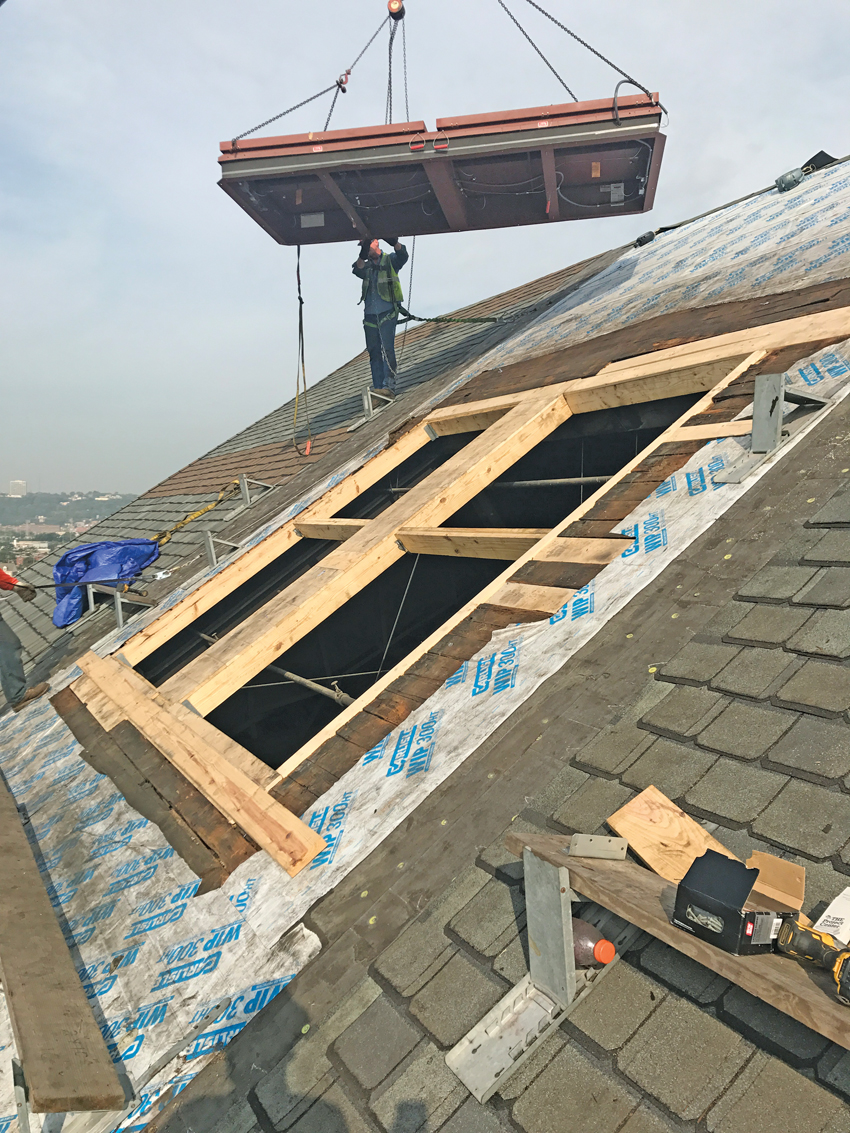
With an OITC value of 46, there are sound-rated smoke vents that isolate sound as effectively as the larger roof structure into which they are installed.
In the case of selecting a sound-rated smoke vent for a performing arts space, the goal is to select a product that is as good as the surrounding roof structure, so that the smoke vent does not compromise the ability of the larger surface to successfully isolate those aggravating environmental sounds. “An OITC value of 46 is pretty substantial,” Merck says. “It is better than a lot of roof systems, especially a metal roof deck. In fact, the typical 6-inch-thick concrete slab that is normal weight has an STC rating of 53 and an OITC value of 46, which means that an acoustic smoke vent with an OITC rating of 46 will provide the same level of sound-isolating performance as the larger structure. This means that a concrete roof deck can be designed to include openings for automatic smoke vents without reducing the overall sound-managing capabilities of the structure. Architects and specifiers will just need to find smoke vents that have achieved a high enough sound-isolation rating to ensure that the integrity of the larger structure is maintained.”
“When it comes to the protection against exterior noise intrusion that can be offered by automatic smoke vents, there are solutions on the market that have earned an OITC rating of 46 and an STC rating of 50,” says Mike Toohey, general manager for The BILCO Company. “These acoustical smoke vents effectively block the lower-frequency sounds generated by traffic, construction, and airplanes, while remaining a reliable life and safety product that protects people and property in the event of a fire.”
Code-Mandated Use of Automatic Smoke Vents
Although much of the discussion in this course up to this point has focused on the ability to provide smoke vent openings without compromising the acoustic integrity of the roof, it is important to address the bigger safety-driven reason that smoke venting is incorporated into a roof in the first place. Automatic smoke vents, sound rated or not, are life-safety products that are typically incorporated into large, one-story buildings to satisfy the several standards and building codes that require their use. Following is a brief exploration into the ways that the National Fire Protection Association (NFPA), the International Building Code (IBC), and the International Fire Code (IFC) define design objectives for and mandate the installation of smoke and heat venting systems.
NFPA 204: Standard for Smoke and Heat Venting, 2018 Edition
The standard identifies design objectives for smoke and heat venting systems and explores vent design constraints, methods of operation, and vent dimensions and spacing, as well as information on air inlets, draft curtains, mechanical smoke exhaust systems, and required inspection and maintenance. Ultimately, NFPA 204 helps designers meet selected performance objectives related to a specific building and a specific set of circumstances. These performance objectives include designing a vent system that will “slow, stop, or reverse the descent of a smoke layer produced by fire in a building by exhausting smoke to the exterior.” By controlling the smoke layer, a well-designed vent system will provide occupants with a safe path of travel to a safe area, facilitate manual firefighting, and reduce the damage to buildings and contents that results from exposure to smoke and hot gases.

The 2018 IBC requires smoke vents in factories, industrial buildings, and storage facilities that have more than 50,000 square feet of undivided area, where the upper surface of the story is a roof, but architects often install these safety devices into other types of buildings, including theaters, convention centers, and performing arts facilities.
Although NFPA 204 is technically referred to as a standard, it does not specify under which conditions venting is to be provided or required. The decision whether to provide venting in a building depends on the design objectives set by a building owner or occupant and on local building and fire code requirements.
The 2002 edition of NFPA 204 was converted from a guide to standard, and the 2018 Edition is its latest iteration. As it describes in Chapter 1, “This standard shall apply to the design of venting systems for the emergency venting of products of combustion from fires in buildings.” Provisions are included to address appropriate designs for both non-sprinklered, single-story buildings and sprinklered buildings.
2018 IBC: Section 910: Smoke and Heat Removal
While NFPA 204 guides the design of automatic venting systems where they are required, the 2018 IBC: Section 910: Smoke and Heat Removal addresses the specific types of buildings that require these automatic smoke and heat vents. Here is the specific language from the code.
910.1 General
Where required by this code, smoke and heat vents or mechanical smoke removal systems shall conform to the requirements of this section.
910.2 Where Required
Smoke and heat vents or a mechanical smoke removal system shall be installed as required by Sections 910.2.1 and 910.2.2. Exceptions include:
- Frozen food warehouses used solely for storage of class I or II commodities where protected by an approved automatic sprinkler system.
- Areas of buildings equipped with early-suppression fast-response (ESFR) sprinklers.
- Areas of buildings equipped with control-mode special-application sprinklers with a response time index of 50 (m-s)1/2 or less that are listed to control a fire in stored commodities with 12 or fewer sprinklers.
910.2.1 Group F-1 or S-1
Smoke and heat vents installed in accordance with Section 910.3 or a mechanical smoke-removal system installed in accordance with Section 910.4 shall be installed in buildings and portions thereof used as a Group F-1 or S-1 occupancy having more than 50,000 square feet (4645 m2) of undivided area. In occupied portions of a building equipped throughout with an automatic sprinkler system in accordance with Section 903.3.1.1 where the upper surface of the story is not a roof assembly, a mechanical smoke removal system in accordance with Section 910.4 shall be installed. Exception: Group S-1 aircraft repair hangars.
910.2.2 High Piled Combustible Storage
Smoke and heat removal required by Table 3206.2 of the International Fire Code (IFC) for buildings and portions thereof containing high-piled combustible storage equipped throughout with an automatic sprinkler system in accordance with Section 903.3.1.1, a smoke-and heat-removal system shall be installed in accordance with Section 910.3 or 910.4. In occupied portions of a building equipped throughout with an automatic sprinkler system in accordance with Section 903.3.1.1, where the upper surface of the story is not a roof assembly, a mechanical smoke-removal system in accordance with Section 910.4 shall be installed.
In summary, the 2018 IBC requires the installation of smoke and heat vents in factories, industrial buildings, and storage facilities that have more than 50,000 square feet of undivided area and where the upper surface of the story is a roof assembly. Table 3206.2 of the IFC (referenced in the code language above) requires smoke and heat removal in high-piled storage areas holding commodity classes I–IV that are greater than 12,000 square feet or considered nonpublic accessible and between 2,501 and 12,000 square feet in size. High-piled storage areas containing commodities deemed 'high hazard' must have a system for smoke and heat removal if the area is larger than 2,501 square feet or identified as nonpublic accessible and between 501 and 2,500 square feet. The IBC and IFC also contain provisions that state the minimum ratio of area of vents provided to the floor area and the maximum spacing of vents. The NFPA also provides guidelines on the ways that smoke vents should be incorporated into a project and the local fire authorities are generally involved in this decision.
The Benefits of Automatic Smoke Vents
Automatic smoke vents are often incorporated in large, single-story, undivided buildings and other types of spaces where they are not required by code. Many architects, engineers, fire authorities, and insurance carriers agree that specifying automatic smoke vents for modern industrial and commercial structures offers significant benefits and dramatically improves outcomes as they relate to the protection of lives and property in the event of a fire. By simply opening a vent door in the roof, automatic smoke vents enable a building’s fire response to better protect the property in a building and the lives of the people and firefighters inside it.
Better Protection for People and Firefighters
These devices remove smoke, heat, and gases from a burning building, which helps people and firefighters move more securely through the compromised interior. People in the building have more time to safely exit the premises and, with less smoke trapped in the structure, the risk of smoke inhalation is decreased. Smoke inhalation is recognized as the number-one cause of death related to fires. This reduction in the amount of smoke inside the building also improves the visibility that firefighters have of the interior once they arrive on the scene. Being able to see the emergency more clearly enables emergency crews to more quickly locate the fire, formulate a plan, and begin fighting it.
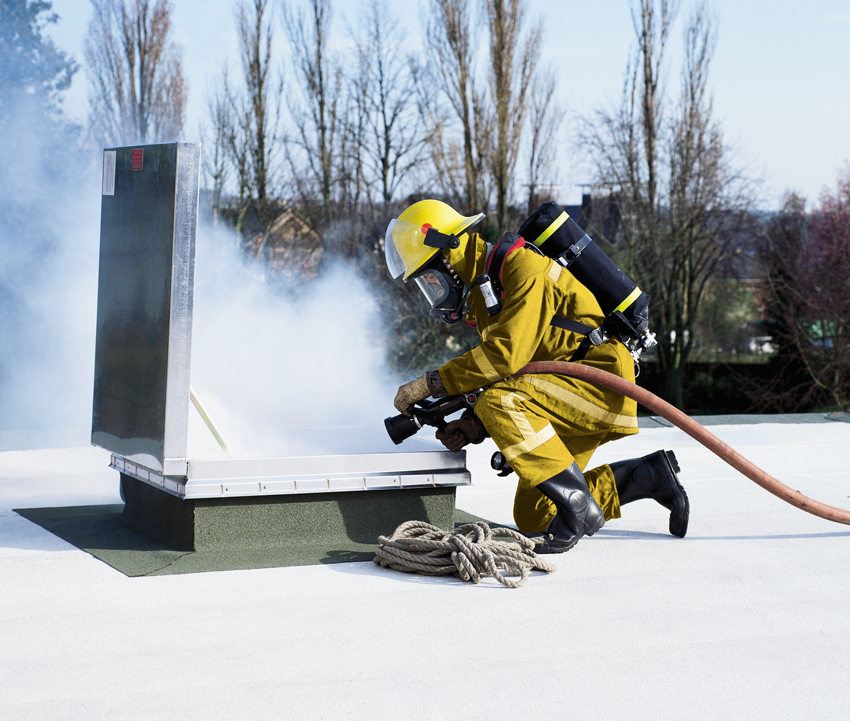
When smoke vents open, releasing smoke and hot gases trapped inside, visibility improves for firefighters, enabling them to more quickly locate the fire.
Fires also release dangerous gases into the air, including carbon monoxide, which is lethal. Smoke from fires often contains a whole host of other toxic threats like hydrogen cyanide and inorganic acids. Exposure to these toxicants can be the principal cause of death found in victims that succumb to these events. During fires, potentially explosive fumes can also be released. Automatic smoke vents remove noxious and potentially explosive gases from the area, making the burning environment safe for people and firefighters to travel through it.
Better Protection for Property
Smoke vent solutions also offer improved protection for the building structure and the property it contains. When correctly implemented, the venting strategy protects against secondary ignitions and lateral fire spread, protects the structure from damaging heat, and reduces the total amount of damage that occurs. Let us take a closer look at how vents on the roof can make such a difference.
When fires start, a smoke plume of hot gases and smoke rises directly above the area of combustion until it hits the ceiling. Unable to break through the ceiling plane, the hot gases and combustion products spread out horizontally under the ceiling surface, quickly reaching areas of the building that are removed from the immediate location of the fire. As the fire continues to burn, more smoke and hot gases rise to the ceiling. The layer of hot gas and smoke at the ceiling thickens and gets hotter. The intense heat building at the ceiling will eventually begin to weaken the structure, increasing the potential danger to the people and firemen on the scene and the amount of damage caused by the fire. Automatic smoke vents slow the buildup of these hot gases at the ceiling and can even reverse it, protecting the structure from the damaging levels of heat that can be produced.
The vents also help to prevent lateral spread by allowing the smoke and gases to exit the building near where they impact the ceiling, instead of spreading out, trapped underneath the ceiling plane. Keeping the fire, smoke, and heat from spreading reduces the opportunities for secondary ignitions and helps to keep sprinklers from activating that are not in the immediate area of the fire. This reduces the unnecessary water damage to property and contents not directly involved in the fire.
Conclusion
Automatic smoke vents are an effective solution for mitigating a great deal of the danger and destruction that could occur during a fire event. These life-safety devices are also capable of mitigating exterior noise and creating an interior environment that sounds great under normal circumstances. Look for sound-rated smoke vents to provide the code-mandated safety equipment without compromising the sound performance of the roof.









